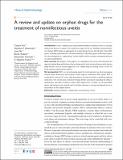| dc.contributor.author | You, Caiyun | en_US |
| dc.contributor.author | Sahawneh, Haitham F | en_US |
| dc.contributor.author | Ma, Lina | en_US |
| dc.contributor.author | Kubaisi, Buraa | en_US |
| dc.contributor.author | Schmidt, Alexander | en_US |
| dc.contributor.author | Foster, C Stephen | en_US |
| dc.date.accessioned | 2017-03-28T23:48:05Z | |
| dc.date.issued | 2017 | en_US |
| dc.identifier.citation | You, Caiyun, Haitham F Sahawneh, Lina Ma, Buraa Kubaisi, Alexander Schmidt, and C Stephen Foster. 2017. “A review and update on orphan drugs for the treatment of noninfectious uveitis.” Clinical Ophthalmology (Auckland, N.Z.) 11 (1): 257-265. doi:10.2147/OPTH.S121734. http://dx.doi.org/10.2147/OPTH.S121734. | en |
| dc.identifier.issn | | en |
| dc.identifier.uri | http://nrs.harvard.edu/urn-3:HUL.InstRepos:31731652 | |
| dc.description.abstract | Introduction: Uveitis, a leading cause of preventable blindness around the world, is a critically underserved disease in regard to the medications approved for use. Multiple immunomodulatory therapy (IMT) drugs are appropriate for uveitis therapy but are still off-label. These IMT agents, including antimetabolites, calcineurin inhibitors, alkylating agents, and biologic agents, have been designated as “orphan drugs” and are widely used for systemic autoimmune diseases or organ transplantation. Area covered The purpose of this paper is to comprehensively review and summarize the approved orphan drugs and biologics that are being used to treat systemic diseases and to discuss drugs that have not yet received approval as an “orphan drug for treating uveitis” by the US Food and Drug Administration (FDA). Our perspective IMT, as a steroid-sparing agent for uveitis patients, has shown promising clinical results. Refractory and recurrent uveitis requires combination IMT agents. IMT is continued for a period of 2 years while the patient is in remission before considering tapering medication. Our current goals include developing further assessments regarding the efficacy, optimal dose, and safety in efforts to achieve FDA approval for “on-label” use of current IMT agents and biologics more quickly and to facilitate insurance coverage and expand access to the products for this orphan disease. | en |
| dc.language.iso | en_US | en |
| dc.publisher | Dove Medical Press | en |
| dc.relation.isversionof | doi:10.2147/OPTH.S121734 | en |
| dc.relation.hasversion | http://www.ncbi.nlm.nih.gov/pmc/articles/PMC5298311/pdf/ | en |
| dash.license | LAA | en_US |
| dc.subject | immunomodulatory | en |
| dc.subject | orphan drug | en |
| dc.subject | steroid sparing | en |
| dc.subject | uveitis | en |
| dc.title | A review and update on orphan drugs for the treatment of noninfectious uveitis | en |
| dc.type | Journal Article | en_US |
| dc.description.version | Version of Record | en |
| dc.relation.journal | Clinical Ophthalmology (Auckland, N.Z.) | en |
| dash.depositing.author | Foster, C Stephen | en_US |
| dc.date.available | 2017-03-28T23:48:05Z | |
| dc.identifier.doi | 10.2147/OPTH.S121734 | * |
| dash.contributor.affiliated | Foster, Charles | |


